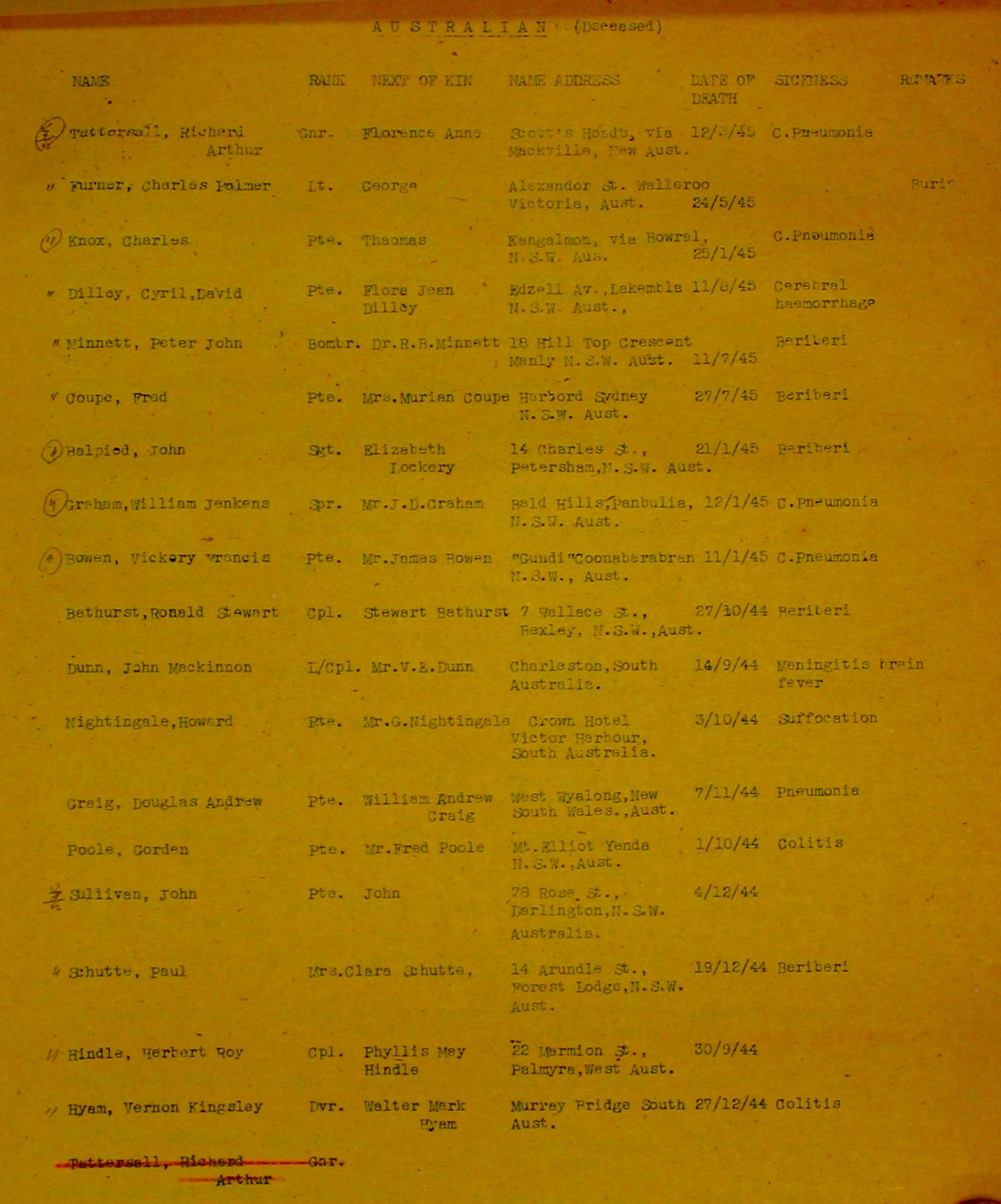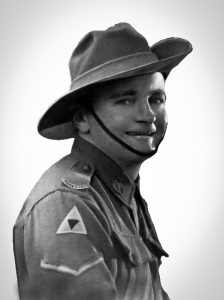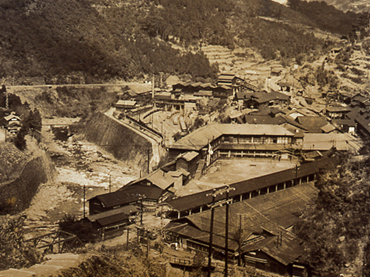Yamane, Hiroshima #3-D - Japan, Sumitomo's Besshi Copper Mine
Yamane, Hiroshima #3-D – Japan
The prisoners bound for Yamane were put onto a train which headed off in an easterly direction from Mojo along the Japanese main island of Honshu. This group of over 250 Australians (including 50 men from 2/4th) was now under the command of Lt Ralph Sanderson from the 2/19th Battalion. When they detrained at Tokoyama they were then put on a barge and towed across the Inland Sea to the port of Matsuyama on Shikoku Island. They were then bundled onto trucks and driven to the Niihama Railway Station from where they were marched 1 and a half miles to their new camp at Yamane.
‘End of the Besshi Copper Mines’ 300-year history
Photo courtesy of Sumitomo Historical Archives (owned by Sumitomo Metal Mining Co., Ltd.)
The is from the Sumitomo website
https://www.sumitomo.gr.jp/english/history/besshidouzan/index04.html
Judging by the weathering of timber used it its construction, this camp had only just been completed. The camp was divided into the two distinct areas that were enclosed by a high wooden fence. One section was for prisoners and the other for the guards, camp offices and parade ground. The Australian prisoners’ accommodation was in hut No. 1, a two- storeyed building about 200 feet long, by 30 feet wide. It was noted to be a good, clean camp. The construction of the buildings in this camp was virtually the same as the Niihama Camp.
The prisoners were bought to this location to work below and above ground at the Sumitomo Besshi copper mine. The mine was located in the Besshi Mountain at an elevation 2,000 feet above sea level, approximately 7 and a half miles to the south of, and overlooking the Port of Niihama. Two mine shafts extended eastward from their entrances for 5 miles into the hills. The mine was not only rich in copper but also gold and bauxite, used in the manufacture of aircraft.
The mine kept 100,000 people gainfully employed and there is no doubting that Niihama’s industry that encompassed an area of 12 and a half miles only existed because of the mine. The copper, aluminium and chemical refineries and foundry of the Yamane-Niihama area were an important contributor towards Japan’s war effort. The copper, bauxite and gold ore was taken from the mine in railway ore cars to the wharf between machinery and chemical plants where it was shipped to Shikan Island for refining. The ores, once refined, were shipped back to the foundry, machinery, chemical and aluminium plants at Niihama.
The Besshi Copper Mine
It was around 11th September, 1944 that the Prisoners of War began working at the mine. Their first, and presumably, a typical day at the Besshi copper mine was as follows:
After breakfast they were marched to the Niihama Railway Station where they were unceremoniously piled into open railway ore trucks for the trip up the mountain. On arrival at the mine the men were paraded outside the mine offices and introduced to Capt Takuji Marukami. In a display of swordmanship before a captive POW audience he convinced all who were paraded before him that they must work hard to mine the copper ore for Japan or he would have their heads. Capt Marukami, from this time forth earned himself the nickname of “lolly lopper” attributed to his impressive demonstration of swordsmanship.
Below: Markami at Wat Trials

Most, but not all the men, were to work below ground. Some of the machine gunners were to work above ground on mine maintenance and repair duties. Jim Elliott WX8619 and Edwin Adams WX8245 worked in the carpentry shop and Claude Dow WX17591 worked as a drill sharpener. There were many 2/4th Machine Gun Battalion Members that were to work below ground in Japan, however this mine would take its toll upon this battalion.
The first casualty from the 2/4th at Yamane was Roy “Dickie” Hindle. Roy died on 30th September 1944 as a result of an underground rock fall. Roy’s body was cremated and his ashes were carried by an Australian officer to Manila. From there they were forwarded onto Labuan War Cemetery for burial.

Another casualty, although not fatal, was that of Arch “Strawb” Dyson WX7599 who in January 1945 was pinned between a copper ore truck and a wall injuring both his legs. Tom Wayman WX75902 was another who suffered injury. Working below ground repairing iron water pipes that had corroded through. Tom’s hand was crushed causing severe nerve damage.
Below: Tom Wayman
Bert Norton WX8493 (above) was pinned by leg under a rock during a cave in. He bore a large scar on his leg and smaller scars on his back to remind him long after the war. He was taken to Gulian Hospital by mine fire engine , cleaned and stitched then to camp with several weeks off work. Then back to mine on light duties for a few days before going back down the shaft. On 18th May 1945 the prisoners were moved from work at the Besshi copper mine to the wharves, smelters and refineries of Niihama. The reason for this move was simply because the men’s health had flagged so much that they were of no further use to the Japanese at the mine site.
We acknowledge the following information is from https://en.wikipedia.org/wiki/Besshi_copper_mine
The Besshi copper mine (別子銅山, Besshi dōzan) was a rich source of copper in Niihama, Ehime Prefecture, Japan. The deposits were discovered in 1690, and copper mining began in the following year. From then until the closing of the mine in 1973, Besshi produced about 700,000 tons of copper, and contributed to Japan’s trade and modernization. The Sumitomo family managed the mine, which helped build the Sumitomo zaibatsu. The Dōzan River was named after the copper mine.
The Minetopia Besshi theme park uses some of the mine’s facilities.
Please read from today’s version of the Beeshi Copper Mine.
Sumitomo apparently has created a very informative museum at Beeshi. It would be simply amazing to know if Sumitomo has acknowledged the POWs and their names – of the men who were forced to work at Beeshi during WW2.

Above: Australian POWs who died, including Dick Hindle.
Hindle aged 40 years, was killed by a fall of rock at Sumitomo Besshi copper mine at Yamane on Shikoku Island Japan on 30.9.1944. His body was cremated and his ashes were carried as far as Labuan Island.
Hindle was father to four children and formerly a competitive Rugby player.
Records show ‘Died after leg severed by fall of stone. (Japanese records state ‘Contusion of the head’).

Please go to this site to enable you to visual the conditions POWs worked in
The illustrations below are an examples of the conditions POWs worked in underground Japan.


Below: Illustration from 1850’s England, depicting the size of the mine’s tunnels


Japan’s miner’s loin cloth was same attire Allied POWs wore below ground during WW2.



